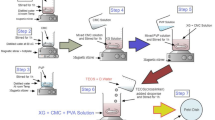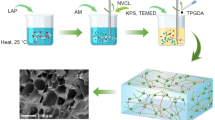Abstract
In this work, the composite hydrogels of polyvinyl alcohol (PVA)–gellan gum (GG)–aluminum ion (Al3+) have been prepared by a repeated freezing and thawing method. By analyzing its structure, mechanical properties and thermal behavior, our result indicates that the ion of Al3+ plays a role of cross-link agent, and it reorganizes the network structure and enhances the mechanical properties for the composite hydrogels. Differential scanning calorimetry has been used to examine the thermal behavior. The melting enthalpy was obtained to evaluate the degree of crystallinity for PVA in hydrogel, which decreases with the increase in the content of GG. The decomposition temperature was obtained to evaluate the thermal stability. And the dehydration activation energy was obtained to evaluate the thermal behavior of water in hydrogel environment. Our result reveals that Al3+ ion enhances the molecular interactions between water and polymer chain, and improves the thermal stability of PVA–GG–Al3+ composite hydrogel. These results will benefit the development of hydrogel in bio-applications.












Similar content being viewed by others
References
Kobayashi M, Toguchida J, Oka M. Preliminary study of polyvinyl alcohol–hydrogel (PVA-H) artificial meniscus. Biomaterials. 2003;24:639–47.
Spiller KL, Laurencin SJ, Charlton D, Maher SA, Lowman AM. Superporous hydrogels for cartilage repair: evaluation of the morphological and mechanical properties. Acta Biomater. 2008;4:17–25.
Qiu Y, Park K. Environment-sensitive hydrogels for drug delivery. Adv Drug Deliv Rev. 2012;64:49–60.
Karimi A, Navidbakhsh M. Mechanical properties of PVA material for tissue engineering applications. Mater Technol. 2014;29:90–100.
Holloway JL, Lowman AM, Palmese GR. Aging behavior of PVA hydrogels for soft tissue applications after in vitro swelling using osmotic pressure solutions. Acta Biomater. 2013;9:5013–21.
Spiller KL, Maher SA, Lowman AM. Hydrogels for the repair of articular cartilage defects. Tissue Eng Part B Rev. 2011;17:281–99.
Stammen JA, Williams S, Ku DN, Guldberg RE. Mechanical properties of a novel PVA hydrogel in shear and unconfined compression. Biomaterials. 2001;22:799–806.
Oka M. Biomechanics and repair of articular cartilage. J Orthop Sci. 2001;6:448–56.
Nuttelman CR, Mortisen DJ, Henry SM, Anseth KS. Attachment of fibronectin to poly(vinyl alcohol) hydrogels promotes NIH3T3 cell adhesion, proliferation, and migration. J Biomed Mater Res. 2001;57:217–23.
Hwang MR, Kim JO, Lee JH, Kim YI, Kim JH, Chang SW, Jin SG, Kim JA, Lyoo WS. Gentamicin-loaded wound dressing with polyvinyl alcohol/dextran hydrogel: gel characterization and in vivo healing evaluation. AAPS PharmSciTech. 2010;11:1092–103.
Chang CY, Lue A, Zhang L. Effects of crosslinking methods on structure and properties of cellulose/PVA hydrogels. Macromol Chem Phys. 2008;209:1266–73.
Koyano T, Minoura N, Nagura M, Kobayashi K. Attachment and growth of cultured fibroblast cells on PVA/chitosan-blended hydrogels. J Biomed Mater Res. 1998;39:486–90.
Prajapati VD, Jani GK, Zala BS, Khutliwala TA. An insight into the emerging exopolysaccharide gellan gum as a novel polymer. Carbohydr Polym. 2013;93:670–8.
D’ArrigoQ G, Navarro G, Meo CD, Matricardi P, Torchilin V. Gellan gum nanohydrogel containing anti-inflammatory and anti-cancer drugs: a multi-drug delivery system for a combination therapy in cancer Treatment. Eur J Pharm Biopharm. 2014;87:208–16.
Oliveira JT, Martins L, Picciochi R, Malafaya PB, Sousa RA. Gellan gum: a new biomaterial for cartilage tissue engineering applications. J Biomed Mater Res A. 2010;93:852–63.
Silva-Correia J, Oliveira JM, Caridade SG, Oliveira JT, Sousa RA, Mano JF, Reis RL. Gellan gum-based hydrogels for intervertebral disc tissue-engineering applications. J Tissue Eng Regen Med. 2011;5:97–107.
Oliveira JT, Gardel LS, Rada T, Martins L, Gomes ME, Reis RL. Injectable gellan gum hydrogels with autologous cells for the treatment of rabbit articular cartilage defects. J Orthop Res. 2010;28:1193–9.
Chandrasekaran R, Radha A. Molecular architectures and functional properties of gellan gum and related polysaccharides. Trends Food Sci Technol. 1995;6:143–8.
Tang YJ, Sun J, Fan HS, Zhang XD. An improved complex gel of modified gellan gum and carboxymethyl chitosan for chondrocytes encapsulation. Carbohydr Polym. 2012;88:46–53.
Tang JM, Tung MA, Zeng YY. Compression strength and deformation of gellan gels formed with mono- and divalent cations. Carbohydr Polym. 1996;29:11–6.
Maiti S, Ranjit S, Mondol R, Ray S, Sa B. Al3+ ion cross-linked and acetalated gellan hydrogel network beads for prolonged release of glipizide. Carbohydr Polym. 2011;85:164–72.
Jana S, Das A, Nayak AK, Sen KK, Basu SK. Aceclofenac-loaded unsaturated esterified alginate/gellan gum microspheres: in vitro and in vivo assessment. Int J Biol Macromol. 2013;57:129–37.
Passos MF, Dias DRC, Bastos GNT, Jardini AL, Benatti ACB, Dias CGBT, Filho RM. pHENA hydrogels synthesis, kinetics and in vitro tests. J Therm Anal Calorim. 2016;125:361–8.
de Carvalho CL, Rosa DS. Thermal oxidative degradation of polypropylene-containing pro-oxidants. J Therm Anal Calorim. 2014;115:1627–32.
Bier JM, Verbeek CJR, Lay MC. Identifying transition temperatures in bloodmeal-based thermoplastics using material pocket DMTA. J Therm Anal Calorim. 2013;112:1303–15.
Ma YH, Bai TC, Wang F. The physical and chemical properties of the polyvinylalcohol/polyvinylpyrrolidone/hydroxyapatite composite hydrogel. Mater Sci Eng C. 2016;59:948–57.
Appel EA, Loh XJ, Jones ST, Biedermann F, Dreiss CA, Scherman OA. Ultrahigh-water-content supramolecular hydrogels exhibiting multistimuli responsiveness. J Am Chem Soc. 2012;134:11767–73.
Ratner BD, Hoffman AS, Hanson SR, Harker LA, Whiffen JD. Blood-compatibility-water-content relationships for radiation-grafted hydrogels. J Polym Sci: Polym Symp. 1979;66:363–75.
Hassan CM, Peppas NA. Structure and applications of poly(vinyl alcohol) hydrogels produced by conventional crosslinking or by freezing/thawing methods. In: Chang JY, Godovsky DY, Hassan CM, editors. Biopolymer PVA hydrogels anionic polymerisation nanocomposites. Adv. Polym. Sci. 2000; 153. p. 37–65.
Liu LM, Wang BH, Gao Y, Bai TC. Chitosan fibers enhanced gellan gum hydrogels with superior mechanical properties and water-holding capacity. Carbohydr Polym. 2013;97:152–8.
Miyoshi E, Takaya T, Nishinari K. Gel–sol transition in gellan gum solutions. I. Rheological studies on the effects of salts. Food Hydrocoll. 1994;8:505–27.
Mahajan HS, Gattani SG. Gellan gum based microparticles of metoclopromide hydrochloride for intranasal delivery: development and evaluation. Chem Pharm Bull. 2009;57:388–92.
Yuguchi Y, Urakawa H, Kitamura S, Wataoka I, Kajiwara K. The sol–gel transition of gellan gum aqueous solutions in the presence of various metal salts. In: Nishinari K, editor. Physical chemistry and industrial application of gellan gum. Progress in Colloid and Polymer Science; 2003. p. 41–7.
Liang JJ, Huang Y, Zhang L, Wang Y, Ma YF. Molecular-level dispersion of graphene into poly(vinyl alcohol) and effective reinforcement of their nanocomposites. Adv Funct Mater. 2009;19:2297–302.
Sudhamani SR, Prasad MS, Sankar KU. DSC and FTIR studies on gellan and polyvinyl alcohol (PVA) blend films. Food Hydrocoll. 2003;17:245–50.
Ricciardi R, Gaillet C, Ducouret G, Lafuma F, Laupretre F. Investigation of the relationships between the chain organization and rheological properties of atactic poly(vinyl alcohol) hydrogels. Polymer. 2003;44:3375–80.
Pelletier S, Hubert P, Payan E, Marchal P, Choplin L, Dellacherie E. Amphiphilic derivatives of sodium alginate and hyaluronate for cartilage repair: rheological properties. J Biomed Mater Res. 2001;54:102–8.
Miyoshi E, Takaya T, Nishinari K. Rheological and thermal studies of gel–sol transition in gellan gum aqueous solutions. Carbohydr Polym. 1996;30:109–19.
Zhao L, Mitomo H, Zhai M, Yoshii F, Nagasawa N, Kume T. Synthesis of antibacterial PVA/CM-chitosan blend hydrogels with electron beam irradiation. Carbohydr Polym. 2003;53:439–46.
Samal KS, Fernandes EG, Chiellini F, Chiellini E. Thermal analysis of PVA/CNTs 2D membrane. J Therm Anal Calorim. 2009;97:859–64.
Dong WF, Wang Y, Huang ChG, Xiang ShF, et al. Enhanced thermal stability of poly(vinyl alcohol) in presence of melanin. J Therm Anal Calorim. 2014;115:1661–8.
Peppas NA, Merrill EW. Crystallization kinetics of poly(vinyl alcohol). J Appl Polym Sci. 1982;27:4787–97.
Tόth K, Aigner Z, Wellinger K, Szabó-Révész P, Sohár G. Thermoanalytical investigation of different hip joint arthropathies. Thermochim Acta. 2010;506:94–7.
Genieva SD, Vlaev LT, Atanassov AN. Study of the thermooxidative degradation kinetics of poly (tetrafluoroethene) using iso-conversional calculation procedure. J Therm Anal Calorim. 2010;99:551–61.
Wang JX, Zhao HB. Error evaluation on pyrolysis kinetics of sawdust using iso-conversional methods. J Therm Anal Calorim. 2016;124:1635–40.
Acknowledgements
This project was funded by state and local joint engineering laboratory for novel functional polymeric materials, and by the priority academic program development of Jiangsu Higher Education Institutions.
Author information
Authors and Affiliations
Corresponding author
Rights and permissions
About this article
Cite this article
Wang, F., Wen, Y. & Bai, T. Thermal behavior of polyvinyl alcohol–gellan gum–Al3+ composite hydrogels with improved network structure and mechanical property. J Therm Anal Calorim 127, 2447–2457 (2017). https://doi.org/10.1007/s10973-016-5757-3
Received:
Accepted:
Published:
Issue Date:
DOI: https://doi.org/10.1007/s10973-016-5757-3




